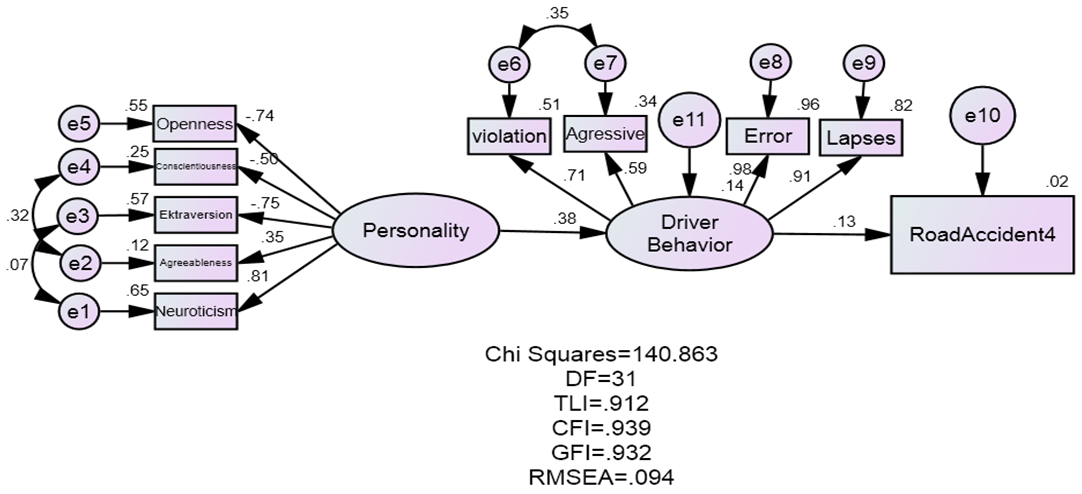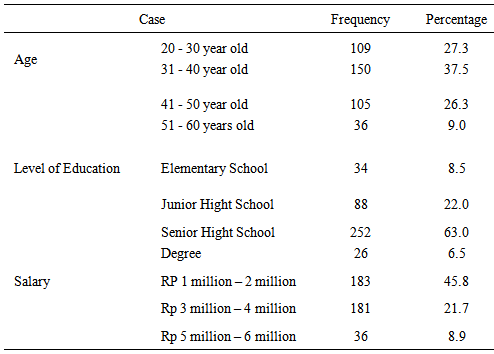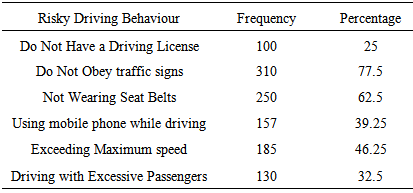-
Paper Information
- Next Paper
- Paper Submission
-
Journal Information
- About This Journal
- Editorial Board
- Current Issue
- Archive
- Author Guidelines
- Contact Us
International Journal of Psychology and Behavioral Sciences
p-ISSN: 2163-1948 e-ISSN: 2163-1956
2015; 5(4): 148-153
doi:10.5923/j.ijpbs.20150504.02
The Model of Personality and Driver Behavior as Mediator on Road Accident Involvement among Bus Driver in Riau Province Indonesia
Fikri1, Rozmi Ismail2, Fatimah Wati Halim2
1PhD student in School of Psychology and Human Development, Universiti Kebangsaan Malaysia and Lecturer in Faculty of Psychology Islamic University of Riau, Indonesia
2School of Psychology and Human Development, Universiti Kebangsaan Malaysia
Correspondence to: Fikri, PhD student in School of Psychology and Human Development, Universiti Kebangsaan Malaysia and Lecturer in Faculty of Psychology Islamic University of Riau, Indonesia.
| Email: |  |
Copyright © 2015 Scientific & Academic Publishing. All Rights Reserved.
This study aims to examines the contribution of personality and driver behavior on road accident among bus driver in Indonesia. The study adopts a survey method to elicit responses from a sample of 400 bus driver who were selected as a Respondent. The Data collecting using the Big Five Personality questionnaires, Driver Behavior questionnaires and Road Accident Inventory. The data collected were analysis confirmatory factor analysis and Structural Equation Model (SEM). The SEM results indicated (a) Bus Driver behavior is violent and error have contribution on road accident in Indonesia 8 (b) the big personality factor had significant influences on the latent mediator, path coefficients from -0,50 (conscientiousness) and -0.74 (openness) to -0.75 (ektraversion). As, predicted the effect of conscientiousness, openness and ektraversion were negative and the influences of Neuroticism and agreeableness were positive (path coefficient = 0.35 and 0.81). As expected by the laten mediator variable for road accident risk was relatively strongly and significantly predicted by the latent mediator variable (path coefficient = 0.13). The five personality factor accounted the 38 % of the unique in aberrant driving behavior. The driving behavior have direct influences 55% of the variances in road accident among bus driver in Indonesia. The factor of driver behavior error and lapses have strong affect to road accident The implication this study show that there is need for an intervention program in order to reduce the prevalence of accident involvement due to personality factors. The latter should be focused on managing driving behavior.
Keywords: Personality, Driver Behavior, Road Accident
Cite this paper: Fikri, Rozmi Ismail, Fatimah Wati Halim, The Model of Personality and Driver Behavior as Mediator on Road Accident Involvement among Bus Driver in Riau Province Indonesia, International Journal of Psychology and Behavioral Sciences, Vol. 5 No. 4, 2015, pp. 148-153. doi: 10.5923/j.ijpbs.20150504.02.
Article Outline
1. Introduction
- Road accidents are one of the major global public health concerns. Every day around the world, more than 3000 people die from road traffic injuries (Pedan & Hyder 2002). It is estimated that each year millions of people spend their time in hospitals after severe crashes and many will never be able to live or work as they used to do. According to the World Health Organization (WHO 2009) almost 1.3 million people were killed globally and 50 million people were injured per year due to road traffic accidents. Therefore, this is equivalent to an average of 3500 deaths per day and correspondingly, an average of 150 deaths per hour. International Traffic Safety Data and Analysis IRTAD (2010) predicted that worldwide 250 million people would be killed or seriously injured over the next 20 years. Moreover, WHO (2009) foretold that global road fatalities would reach 1.9 million by 2010. Without appropriate action, by 2020, road traffic injuries are expected to become the third leading contributor to the global burden of injuries (Pedan & hyder 2002).In Asia, it is estimated that the number of fatalities is bout 700,000 annually that is more than half of the world’s road fatalities (Economic and Social Commission for Asian and the Pacific, ESCAP 2010). By 2020, it is estimated that two thirds of the wolrd road fatalities will occur in region (ESCAP 2010). Traffic accidents and fatalities have tremendously risen in most developing countries around the world and Malaysia has not been spared from this. In fact, the nature of road safety issues in developing countries is different from that in developed countries. Jacobs, Aeron and A strop (2000) estimated that the majority of deaths (85%) from road crashes occur in developing countries and almost half occurs in the Asia-Pacific region. In Asia, most of those killed or injured in road accidents are vulnerable road user, especially motorcyclist. In East-Asian and South-East Asian countries, more than two thirds of the victims are motorcyclist (ESCAP 2010).Scholars (Reason, Manstead, Stradling, Baxter & Campbell 1990; Parker, Reason, Manstead, Stardling 1995a; Lajunen, Parker 2001; Ulleberg & Rundmo 2003; Schwebel, Severson, Ball & Rizzo 2006; Bener, Burgut, Sidahmed, Albuz, Sanya & Ali Khan 2009) are still searching to identify and understand the realtive effect of vehicle, road, environment and human characteristics on the risk of accidental events and fatalities. Indonesia government had really tried to reduce national trend in road accident by implementing government policy, but relationship between human factors and accident are complex, thus it is a challenge for psychology to provide additional solutions.The case of road accident In Indonesia increased from year to year, according to the Global Status Report on Road Safety which is delivered by the WHO. Indonesia occupies the first level of road accident improvement. Indonesia reported an increase in the case of road accident by more than 80 per cent. In Indonesia, the number who died as a result of road accident highway reaches 120 people per day. Buse on literature review the factors causing road accidents, human components are one of the largest contributors to the occurrence of road traffic accidents (Grayson and Maycock 1988). Review of accidents caused by human factors supported by Preston and Harris (1965) and Salleh (2008) who found that road accidents caused by four chief factors, namely human factors, mechanical, environmental and animal. But according to the four factors Engglan (2008) factors of road accidents are caused by human factors. Human factors is the dominant factor that accounted for 80 % to 98 % of road accidents (Spring 2003, Yilmaz and Celik 2004, Rozmi 2006, Wundersitz 2008).Driver behavior and Personality is two aspect that is the focus of psychological studies scholars drive. Driver behavior is one of the main causes of the increasing number of road accidents and it is one picture of the vulnerability stemming from human factors (Spring 2003; Rozmi 2006).
2. Method
2.1. Participant and Procedure
- The sample initially consisted of 400 bus driver from 13 city in Riau Province Indonesia. Drivers were approach by a group of university student who were trained on data collection and interview techniques, and only those who agree to fill out the questionnaire and have driving license were include in the study. The participant ware assured about anonymity and confidentiality of their respondent.
2.2. Instruments
- The Malaysia Version of Driver Behavior questionnaire (DBQ) (Afsane & Rozmi Ismail, 2013) with seven item addition items was used to measures driver behavior (Sumer, Ozkan & Lajunen, 2002) participant ware asked to indicate how often they commited each the 35 behavior in the previous yeasr on a 6-point (0=never, 5=Nearly all the time).The Big Five Inventory (BFI, Benet-Martinez & Jhon, 1998) was employed to measure the five personality trait. The Big Five Inventory consist 44 items, allowing researchers quickly and efficiently assess the five personality Dimensions, the dimensions is openness, conscientiousness, ektraversion, agreeableness, and Neuroticism.Demographics and accident history. The respondent of this research were asked to indicate their age, Frequency of driving, the number of accident and offences during 5 years.
2.3. Statistical Analyses
- The Traditional strategy among traffic psychology has been investigate the association between single measures of personality variable and various outcome measures including incident involvement. Unfortunately, correlations between variables may be exaggerated by common method variance or attenuated by random error of measurement when single indicators are employed in measuring construct (Hoyle, 1995).This study using structural Equation modeling (SEM) with multiple indicator for three constructs: Personality, Driver behaviors and Road Accidents.In testing the purpose model, conventional, cut-off criteria and fit indices were used (Nebi Sumer & Lajunen, 2005) this indices involved goodness of fit index (GFI), adjusted goodness of fit (AGFI), DF ratio and root mean squares error approximation (RMSEA).
3. Result
3.1. Demographic Profile
- In this section we discuss the results of the study that was done by the researcher. About descriptive data social- demographic risk drivers in the city of Pekanbaru, as seen in Table 1 below.
|
|
3.2. The Correlation of Variable
- The descriptive analysis of the personality dimensions by using the Big Five Personality Inventory test has resulted in high trait Openness (M = 32.63, SD = 3.79), high trait Prudential (M = 31.27, SD = 3.27), high extrovert trait (M = 26.90, SD = 3:24), trait agreeableness high (M = 32.63, SD = 3:36), and trait Neuroticism relatively low (M = 22:43, SD = 2.8. Meanwhile, the test tool Buss & Perry Aggression Questionnaire, results descriptive analysis showed a relatively low physical assault (M = 21.70, SD = 5:21), verbal attacks are relatively low (M = 13:57, SD = 2.94), anger is quite low (M = 19:23, SD = 5.20) and hostility relatively low (M = 22:40, SD = 5:10). Finally, the Sensation Seeking Scale test instrument, the results show the dimensions of Sensation Seeking relatively low (M = 15.13, SD = 2.16) and relatively low impulsivity (M = 7.90, SD = 2:42). Pearson correlation test results revealed that there was a significant relationship between trait neuroticism with physical attacks (r = 0.58) and trait-trait personality dimensions other aggressive behavior towards others showed low correlation is not significant. Moreover, the dimensions agreeableness found to have a significant relationship with sensation seeking (r = -0.38). Meanwhile, other personality dimensions found to have no significant relationship with the sensation-seeking and impulsivity. The analysis also found that the verbal attacks have a significant relationship with the sensation-seeking (r = - 0.39) and anger also found to have a significant relationship with the sensation-seeking (r = -0.41). Meanwhile, the other dimensions of aggressive behavior was found to be significantly correlated with sensation-seeking and impulsivity.
 | Table 3. The Analysis of Correlation of Personality Factor, Driver Behavior, on Road Accident |
3.3. Structural Equation Modeling (SEM)
- The result of Structural Equation modeling (SEM) find that the model of bus driver personality in Indonesia is the driver have good neuroticism or stability of emotion and openness, with factor loading value =.78 for neuroticism and the value of loading factor = .32 for openness factor, but the loading factor driver personality ektravertion = -.52, Agreeableness = -.75 and conscientiousness = -.76 with Chi squares = 12.260, TLI = .963, The value of goodness of fit index (GFI) is = .988, adjusted goodness of fit (AGFI), DF ratio = 4, and root mean squares error approximation (RMSEA) = .072. The model of personality can see from Figure 1.
 | Figure 1. The Model of Big Five Personality Bus Driver in Indonesia |
 | Figure 2. The model of Driver Behavior on Road Accident on Driver behavior in Indonesia |
 | Figure 3. The Model of Personality and Driver Behavior on Road Accident Involvement on Bus Driver in Riau Province Indonesia |
- Supporting the mediated association, SEM analyses revealed that all of the indirect effect of the big five factor on road accident among bus driver in Indonesia via aberrant driving behavior were statistically significant with path coefficient = 0.38. Finally, the five personality factor accounted the 38% of the unique in aberrant driving behavior. The driving behavior have direct influences 55% of the variances in road accident among bus driver in Indonesia. The factor of driver behavior error and lapses have strong affect to road accident. You can see the result of the SEM analysis bellow in figure 3.
4. Conclusions
- The results of this study have shown that there are have influences of personality and risky behavior driving on road accident among bus driver. big personality factor had significant influences on the latent mediator, path coefficients from -0,50 (conscientiousness) and -0.74 (openness) to -0.75 (ektraversion). As, predicted the effect of conscientiousness, openness and ektraversion were negative and the influences of Neuroticism and agreeableness were positive (path coefficient = 0.35 and 0.81). As expected by the laten mediator variable for road accident risk was relatively strongly and significantly predicted by the latent mediator variable (path coefficient = 0.13). The five personality factor accounted the 38% of the unique in aberrant driving behavior. The driving behavior have direct influences 55% of the variances in road accident among bus driver in Indonesia.The result of this study supporting our hypothesis, result demonstrated that conscientiousness) and -0.74 (openness) to -0.75 (ektraversion). Had stronger predicted fower than agreebalenes and neuroticism. This result different with another previous studies, (e.g Arthur & Graziano, 1996, Clark & Robertson, 2005) they find that just only conscientiousness have a strong direct effect on driving behavior and direct effect to road accident, another researcher Rozmi Ismail et al (2009) also found that the influence of the driving experience can serve as a predictor of the involvement of an accident and aggressive driving behavior on the road. The study by Finken, et al (1998) about the risks of driving and the influence of experience was also found that the high trend of going to the occurrence of accidents caused by drivers lack experience compared to older drivers. These findings are also supported by Jessor (1997) and Mather (2007), their study also found that bus driver have risk level higher than another driver. According to Bettencourt, et al (2006) the characteristics and personality type driver have the contribution on road accident and driver behavior have strong effect to bus driver on road accident.A study conducted by Rozmi Ismail (2005) using a total of 200 respondents found that the frequency of error as well as breaking the law has influenced the gender and age of the driver. Most drivers make mistakes and errors while driving is a woman driver but they rarely break the law. While male drivers more often breaching roads and deviant behavior was correlated with the number of accidents recorded. While in terms of age teens doing a lot more risk drivers when compared to drivers age adults.Public transport has a very important role in the establishment of a state. Public transport is a very important in our efforts to develop the country in all aspects of life and the strength and unity of a nation. Drivers are an important part of public transportation. Because they are very instrumental in running and developing public transport. The number of accidents on the road are we supposed to take that into consideration. Risky driving behavior that has been identified as one of the factors that affect the amount of accidents on the road. The findings of these studies have concluded that a factor of personality and driver behavior have a higher risk on road accident. The increasing number of road traffic accidents in Indonesia also cause by this factor. Therefore, all parties, especially psychologists, community and the government of Indonesia take part in work to understand the problem and develop a plan to reduce this problem.
 Abstract
Abstract Reference
Reference Full-Text PDF
Full-Text PDF Full-text HTML
Full-text HTML
